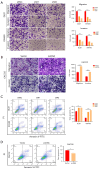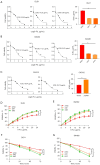ABALON regulates mitophagy and 5-FU sensitivity in colorectal cancer via PINK1-Parkin pathway
- PMID: 39697760
- PMCID: PMC11651798
- DOI: 10.21037/tcr-24-933
ABALON regulates mitophagy and 5-FU sensitivity in colorectal cancer via PINK1-Parkin pathway
Abstract
Background: Growing evidence demonstrated that long non-coding RNAs (lncRNAs) are closely related with chemoresistance in colorectal cancer (CRC). Mitophagy serves as an essential factor to maintain the quality of tumor cells. However, it is unclear whether lncRNAs are involved in mitophagy regulation in CRC. The aim of this study is to evaluate whether lncRNAs are involved in regulating mitophagy and chemoresistance in CRC.
Methods: In this study, gain/loss of function was used to analyze the biological function influenced by apoptotic BCL2L1-antisense long non-coding RNA (ABALON). Western blot and JC-1 probe were carried out for detecting mitophagy. Chemosensitivity of CRC cells to 5-fluorouracil (5-FU) was determined using cell counting kit-8 (CCK-8), flow cytometry, colony formation and trans well assays.
Results: We found that ABALON expression was increased in CRC, especially in consensus molecular subtype 1 (CMS1) and highly expressed ABALON was related with tumor differentiation, tumor node metastasis (TNM) staging, and lymph node metastasis (P<0.05). ABALON knockdown led to impaired proliferation and enhanced apoptosis in CRC. Mitophagy variations primed by ABALON enhanced mitochondrial homeostasis. The half maximal inhibitory concentration (IC50) of 5-FU in ABALON interference groups declined, while ABALON overexpression elevated IC50. Furthermore, defective mitophagy not only rescued the proliferation, metastasis, and apoptosis induced by ABALON overexpression, but also, enhanced the anti-tumor effect of 5-FU in vivo.
Conclusions: Collectively, our study proposed that ABALON potentiates CRC progression via PINK1/Parkin mediated mitophagy, and ABALON is a promising therapeutic target in reversing 5-FU resistance.
Keywords: 5-fluorouracil (5-FU); Colorectal cancer (CRC); long non-coding RNA (lncRNA); mitophagy; sensitivity.
2024 AME Publishing Company. All rights reserved.
Conflict of interest statement
Conflicts of Interest: All authors have completed the ICMJE uniform disclosure form (available at https://tcr.amegroups.com/article/view/10.21037/tcr-24-933/coif). The authors have no conflicts of interest to declare.
Figures







Similar articles
-
Microbial metabolite sodium butyrate enhances the anti-tumor efficacy of 5-fluorouracil against colorectal cancer by modulating PINK1/Parkin signaling and intestinal flora.Sci Rep. 2024 Jun 6;14(1):13063. doi: 10.1038/s41598-024-63993-x. Sci Rep. 2024. PMID: 38844824 Free PMC article.
-
Exosome-Mediated Transfer of circ_0000338 Enhances 5-Fluorouracil Resistance in Colorectal Cancer through Regulating MicroRNA 217 (miR-217) and miR-485-3p.Mol Cell Biol. 2021 Apr 22;41(5):e00517-20. doi: 10.1128/MCB.00517-20. Print 2021 Apr 22. Mol Cell Biol. 2021. PMID: 33722958 Free PMC article.
-
Circular RNA protein tyrosine kinase 2 (circPTK2) promotes colorectal cancer proliferation, migration, invasion and chemoresistance.Bioengineered. 2022 Jan;13(1):810-823. doi: 10.1080/21655979.2021.2012952. Bioengineered. 2022. Retraction in: Bioengineered. 2023 Dec;14(1):2269352. doi: 10.1080/21655979.2023.2269352. PMID: 34974791 Free PMC article. Retracted.
-
SQYC formula improves the efficacy of PD-1 monoclonal antibodies in MSS colorectal cancer by regulating dendritic cell mitophagy via the PINK1-Parkin pathway.Phytomedicine. 2025 Mar;138:156388. doi: 10.1016/j.phymed.2025.156388. Epub 2025 Jan 11. Phytomedicine. 2025. PMID: 39826284
-
The lncRNA DLGAP1-AS1/miR-149-5p/TGFB2 axis contributes to colorectal cancer progression and 5-FU resistance by regulating smad2 pathway.Mol Ther Oncolytics. 2021 Jan 16;20:607-624. doi: 10.1016/j.omto.2021.01.003. eCollection 2021 Mar 26. Mol Ther Oncolytics. 2021. PMID: 33816780 Free PMC article.
Cited by
-
Evaluation of PINK1 protein expression as a predictive marker for the efficacy of adjuvant chemotherapy in colorectal cancer: a retrospective study.BMC Gastroenterol. 2025 Aug 13;25(1):582. doi: 10.1186/s12876-025-04197-z. BMC Gastroenterol. 2025. PMID: 40804659 Free PMC article.
References
-
- André T, de Gramont A, Vernerey D, et al. Adjuvant Fluorouracil, Leucovorin, and Oxaliplatin in Stage II to III Colon Cancer: Updated 10-Year Survival and Outcomes According to BRAF Mutation and Mismatch Repair Status of the MOSAIC Study. J Clin Oncol 2015;33:4176-87. 10.1200/JCO.2015.63.4238 - DOI - PubMed
LinkOut - more resources
Full Text Sources
Research Materials
